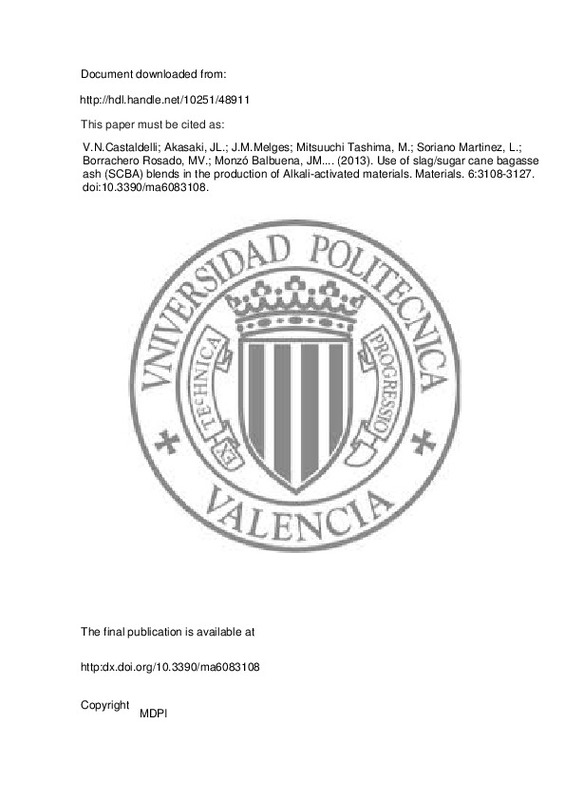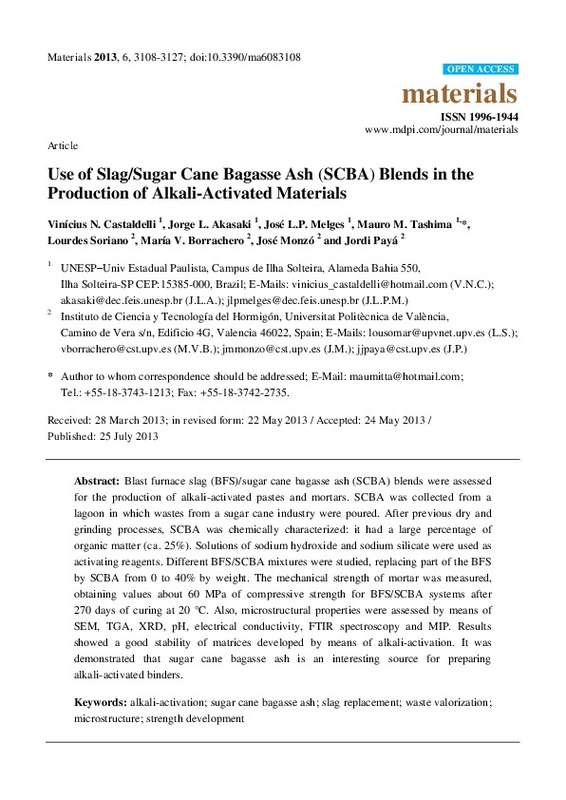Aı̈tcin, P.-C. (2000). Cements of yesterday and today. Cement and Concrete Research, 30(9), 1349-1359. doi:10.1016/s0008-8846(00)00365-3
Flatt, R. J., Roussel, N., & Cheeseman, C. R. (2012). Concrete: An eco material that needs to be improved. Journal of the European Ceramic Society, 32(11), 2787-2798. doi:10.1016/j.jeurceramsoc.2011.11.012
Juenger, M. C. G., Winnefeld, F., Provis, J. L., & Ideker, J. H. (2011). Advances in alternative cementitious binders. Cement and Concrete Research, 41(12), 1232-1243. doi:10.1016/j.cemconres.2010.11.012
[+]
Aı̈tcin, P.-C. (2000). Cements of yesterday and today. Cement and Concrete Research, 30(9), 1349-1359. doi:10.1016/s0008-8846(00)00365-3
Flatt, R. J., Roussel, N., & Cheeseman, C. R. (2012). Concrete: An eco material that needs to be improved. Journal of the European Ceramic Society, 32(11), 2787-2798. doi:10.1016/j.jeurceramsoc.2011.11.012
Juenger, M. C. G., Winnefeld, F., Provis, J. L., & Ideker, J. H. (2011). Advances in alternative cementitious binders. Cement and Concrete Research, 41(12), 1232-1243. doi:10.1016/j.cemconres.2010.11.012
Chinese Construction Bubble–Preparing for a Potential Bursthttp://pt.scribd.com/doc/58599536/SocGenChinaConstruction
Roy, D. M. (1999). Alkali-activated cements Opportunities and challenges. Cement and Concrete Research, 29(2), 249-254. doi:10.1016/s0008-8846(98)00093-3
Van Deventer, J. S. J., Provis, J. L., & Duxson, P. (2012). Technical and commercial progress in the adoption of geopolymer cement. Minerals Engineering, 29, 89-104. doi:10.1016/j.mineng.2011.09.009
McLellan, B. C., Williams, R. P., Lay, J., van Riessen, A., & Corder, G. D. (2011). Costs and carbon emissions for geopolymer pastes in comparison to ordinary portland cement. Journal of Cleaner Production, 19(9-10), 1080-1090. doi:10.1016/j.jclepro.2011.02.010
Pacheco-Torgal, F., Castro-Gomes, J., & Jalali, S. (2008). Alkali-activated binders: A review. Construction and Building Materials, 22(7), 1305-1314. doi:10.1016/j.conbuildmat.2007.10.015
Bakharev, T., Sanjayan, J. G., & Cheng, Y.-B. (1999). Alkali activation of Australian slag cements. Cement and Concrete Research, 29(1), 113-120. doi:10.1016/s0008-8846(98)00170-7
Fernández-Jiménez, A., Palomo, J. G., & Puertas, F. (1999). Alkali-activated slag mortars. Cement and Concrete Research, 29(8), 1313-1321. doi:10.1016/s0008-8846(99)00154-4
Palomo, A., Grutzeck, M. W., & Blanco, M. T. (1999). Alkali-activated fly ashes. Cement and Concrete Research, 29(8), 1323-1329. doi:10.1016/s0008-8846(98)00243-9
Somna, K., Jaturapitakkul, C., Kajitvichyanukul, P., & Chindaprasirt, P. (2011). NaOH-activated ground fly ash geopolymer cured at ambient temperature. Fuel, 90(6), 2118-2124. doi:10.1016/j.fuel.2011.01.018
Duxson, P., Lukey, G. C., & van Deventer, J. S. J. (2007). The thermal evolution of metakaolin geopolymers: Part 2 – Phase stability and structural development. Journal of Non-Crystalline Solids, 353(22-23), 2186-2200. doi:10.1016/j.jnoncrysol.2007.02.050
Tashima, M. M., Soriano, L., Borrachero, M. V., Monzó, J., Cheeseman, C. R., & Payá, J. (2012). Alkali activation of vitreous calcium aluminosilicate derived from glass fiber waste. Journal of Sustainable Cement-Based Materials, 1(3), 83-93. doi:10.1080/21650373.2012.742610
Puertas, F., García-Díaz, I., Barba, A., Gazulla, M. F., Palacios, M., Gómez, M. P., & Martínez-Ramírez, S. (2008). Ceramic wastes as alternative raw materials for Portland cement clinker production. Cement and Concrete Composites, 30(9), 798-805. doi:10.1016/j.cemconcomp.2008.06.003
Reig, L., Tashima, M. M., Borrachero, M. V., Monzó, J., Cheeseman, C. R., & Payá, J. (2013). Properties and microstructure of alkali-activated red clay brick waste. Construction and Building Materials, 43, 98-106. doi:10.1016/j.conbuildmat.2013.01.031
Pacheco-Torgal, F., Castro-Gomes, J., & Jalali, S. (2009). Tungsten mine waste geopolymeric binder: Preliminary hydration products investigations. Construction and Building Materials, 23(1), 200-209. doi:10.1016/j.conbuildmat.2008.01.003
Payá, J., Borrachero, M. V., Monzó, J., Soriano, L., & Tashima, M. M. (2012). A new geopolymeric binder from hydrated-carbonated cement. Materials Letters, 74, 223-225. doi:10.1016/j.matlet.2012.01.132
Tashima, M. M., Akasaki, J. L., Melges, J. L. P., Soriano, L., Monzó, J., Payá, J., & Borrachero, M. V. (2013). Alkali activated materials based on fluid catalytic cracking catalyst residue (FCC): Influence of SiO2/Na2O and H2O/FCC ratio on mechanical strength and microstructure. Fuel, 108, 833-839. doi:10.1016/j.fuel.2013.02.052
Kourti, I., Rani, D. A., Deegan, D., Boccaccini, A. R., & Cheeseman, C. R. (2010). Production of geopolymers using glass produced from DC plasma treatment of air pollution control (APC) residues. Journal of Hazardous Materials, 176(1-3), 704-709. doi:10.1016/j.jhazmat.2009.11.089
Onisei, S., Pontikes, Y., Van Gerven, T., Angelopoulos, G. N., Velea, T., Predica, V., & Moldovan, P. (2012). Synthesis of inorganic polymers using fly ash and primary lead slag. Journal of Hazardous Materials, 205-206, 101-110. doi:10.1016/j.jhazmat.2011.12.039
Puligilla, S., & Mondal, P. (2013). Role of slag in microstructural development and hardening of fly ash-slag geopolymer. Cement and Concrete Research, 43, 70-80. doi:10.1016/j.cemconres.2012.10.004
Bernal, S. A., Rodríguez, E. D., Mejía de Gutiérrez, R., Gordillo, M., & Provis, J. L. (2011). Mechanical and thermal characterisation of geopolymers based on silicate-activated metakaolin/slag blends. Journal of Materials Science, 46(16), 5477-5486. doi:10.1007/s10853-011-5490-z
Bernal, S. A., Provis, J. L., Rose, V., & Mejía de Gutierrez, R. (2011). Evolution of binder structure in sodium silicate-activated slag-metakaolin blends. Cement and Concrete Composites, 33(1), 46-54. doi:10.1016/j.cemconcomp.2010.09.004
Puertas, F., Martı́nez-Ramı́rez, S., Alonso, S., & Vázquez, T. (2000). Alkali-activated fly ash/slag cements. Cement and Concrete Research, 30(10), 1625-1632. doi:10.1016/s0008-8846(00)00298-2
Villar-Cociña, E., Frías Rojas, M., Valencia Morales, E., & Savastano, H. (2009). Study of the pozzolanic reaction kinetics in sugar cane bagasse–clay ash/calcium hydroxide system: kinetic parameters and pozzolanic activity. Advances in Cement Research, 21(1), 23-30. doi:10.1680/adcr.2007.00042
Cordeiro, G. C., Toledo Filho, R. D., & Fairbairn, E. M. R. (2009). Effect of calcination temperature on the pozzolanic activity of sugar cane bagasse ash. Construction and Building Materials, 23(10), 3301-3303. doi:10.1016/j.conbuildmat.2009.02.013
Payá, J., Monzó, J., Borrachero, M. V., Díaz-Pinzón, L., & Ordóñez, L. M. (2002). Sugar-cane bagasse ash (SCBA): studies on its properties for reusing in concrete production. Journal of Chemical Technology & Biotechnology, 77(3), 321-325. doi:10.1002/jctb.549
Tippayasam, C., Boonsalee, S., Sajjavanich, S., Ponzoni, C., Kamseu, E., & Chaysuwan, D. (2010). Geopolymer Development by Powders of Metakaolin and Wastes in Thailand. Advances in Science and Technology, 69, 63-68. doi:10.4028/www.scientific.net/ast.69.63
Haha, M. B., Lothenbach, B., Le Saout, G., & Winnefeld, F. (2011). Influence of slag chemistry on the hydration of alkali-activated blast-furnace slag — Part I: Effect of MgO. Cement and Concrete Research, 41(9), 955-963. doi:10.1016/j.cemconres.2011.05.002
Buchwald, A., Hilbig, H., & Kaps, C. (2007). Alkali-activated metakaolin-slag blends—performance and structure in dependence of their composition. Journal of Materials Science, 42(9), 3024-3032. doi:10.1007/s10853-006-0525-6
Ortego, J. D., Barroeta, Y., Cartledge, F. K., & Akhter, H. (1991). Leaching effects on silicate polymerization. An FTIR and silicon-29 NMR study of lead and zinc in portland cement. Environmental Science & Technology, 25(6), 1171-1174. doi:10.1021/es00018a024
[-]










